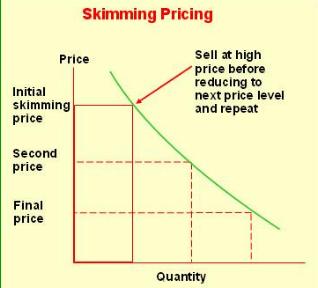Price Skimming: How to Ride Down the Demand Curve
 PriceBeam
·
3 minute read
PriceBeam
·
3 minute read

The ultimate goal for any pricing strategy is setting a price that is as close to the customer’s willingness to pay as possible. The more value the customer gets from purchasing the product, the higher his or her willingness to pay is: and the idea is that those who get the most utility from a product will also make the greatest contribution to the company’s profit.
Price skimming is a classic pricing strategy that enable companies to capture a bigger chunk of consumer surplus and increase profits.
Price skimming involves setting a high launch-price, which is then gradually reduced along the product lifecycle as the customers’ willingness to pay decline. Of course, this strategy assumes that the willingness to pay is, in fact, declining -- which is often marked by a first-mover segment with low price-sensitivity.
The Profitable Early Adopters
The early adopters are the backbone of a price skimming pricing strategy. They gain a feeling of importance from adopting trends and buying products at an early stage, as they wish to project an image of being a ‘trendsetting’ and ‘innovative’ person.
Moreover, early adoption comes with certain risks: the information at the early stage in the product’s lifecycle is scarce, and thus, early adopters rely very much on their own knowledge about the product. We all have that techy friend who has an opinion of all new tech products, and if he sees something he likes, he’ll get it right away -- he may even queue in front of the store prior to the release. This is the quintessential early adopter, who has sufficient knowledge about the product to take on the risk of early adoption.
Due to the knowledge required for early adoption, the typical early adopter also holds above-average education -- i.e. early adopters are associated with relatively smart people. Of course, your IQ won’t increase overnight because you buy the new iPhone on its release date - but it will influence your social status. And THAT’S what we’re after! Because customers are willing to pay loads of money to build a social image that is aligned with their own self-perception.
Understanding early adopters’ way of thinking will help you set the right launch price. Consider this: Early Adopters’ image is reinforced by taking high risk by purchasing an early-stage product, and by owning a product that no one else has (if everyone else adopts it, they’re not really early adopters, right?). What can you do to help them build this image?
Well, if you’re setting a low launch price you’re certainly not doing them a favour -- the lower the launch price, the lower the risk: and if there’s low risk, any fool can buy the product at this point in time. Furthermore, you will see that any fool will buy it: that is, everyone will adopt the product at an early stage, and the early adopters will lose their glory -- and instead, they’ll buy your competitors’ product, since this will at least be different from what everyone else has, and they can maybe even use the aforementioned authority to convince everyone else that this is a smart choice.
This leads us to word of mouth: as early adopters typically are very knowledgeable about the respective product, they have a certain amount of authority and credibility when it comes to word of mouth marketing said product. This is part of the reason why they adopt early in the first place: they gain a feeling of importance from possessing such authority. And once they obtain it, they want to use it by assisting their peers with making smart choices within their area of expertise.
Therefore, pricing and marketing for early adopters are of the essence when employing a price skimming strategy. If you fail to do this, no one (almost) will buy at the initial price.
Riding Down the Demand Curve
Set the initial price too low, and early adopters will lose their glory - set it too high, and even they won’t take the risk of purchasing your product. Therefore, getting the launch price right is crucial and such price is best set by using pricing research and customer data.
Once the launch-price is set, it’s time to gradually lower the price as willingness to pay declines: what is popularly referred to as “riding down the demand curve” as illustrated below:

The first thing to consider is when and by how much. As mentioned above, early adopters expect that the product is kept ‘exclusive’ for a certain period of time, and lowering the price too early will deprive them of this feeling. Consequently, they will react very strongly, and certainly think twice before ‘moving first’ on your next product. Secondly, if the price is lowered too much, the product will be everywhere as even the most price-sensitive customers can afford it. While it may be good for sales, it may be the last time you ever apply an efficient price skimming strategy.
Apple learned this the hard way when they lowered their price by 33% just two months after launching their first iPhone: sales were going great, but those early adopters were roaring.
The key takeaway is that you should resist the temptation to lower prices right away, even if the early adopters’ word of mouth marketing doesn’t seem to catch on. And, most importantly, you should resist the temptation to chase short-term sales increases -- at least if you want to skim profits in the future.
.png?width=400&height=100&name=PBLogoTransparent%20(1).png)




